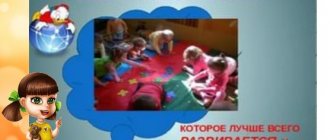1. “Let’s listen to our breathing”
Goal: to teach children to listen to their breathing, determine the type of breathing, its depth, frequency and, based on these signs, the state of the body.
I.p.: standing, sitting, lying down (as convenient at the moment). The muscles of the torso are relaxed.
In complete silence, children listen to their own breathing and determine:
- where the air stream enters and where it comes out;
- what part of the body moves when inhaling and exhaling (stomach, chest, shoulders or all parts - wave-like);
- what type of breathing: shallow (light) or deep;
- what is the breathing frequency: inhalation and exhalation occur frequently or calmly at a certain interval (automatic pause);
- quiet, inaudible breathing or noisy breathing.
2. “Breathe quietly, calmly and smoothly”
Goal: to teach children to relax and restore the body after physical activity and emotional excitement; regulate the breathing process, concentrate attention on it in order to control the relaxation of your body and psyche.
I.p.: standing, sitting, lying down (this depends on the previous physical activity). If you are sitting with your back straight, it is better to close your eyes.
Inhale slowly through your nose. When the chest begins to expand, stop inhaling and pause as long as you can. Then exhale smoothly through the nose. Repeat 5-10 times. The exercise is performed silently, smoothly, so that even a palm placed to the nose does not feel the stream of air when exhaling.
3. “Breathe through one nostril.”
Goal: to teach children to strengthen the muscles of the respiratory system, nasopharynx and upper respiratory tract.
I.p.: sitting, standing, the torso is straightened, but not tense.
- Close the right nostril with the index finger of the right hand. Take a quiet, long breath with your left nostril (consecutively lower, middle, upper breathing).
- As soon as the inhalation is completed, open the right nostril and close the left one with the index finger of the left hand - through the right nostril, exhale quietly for a long time, emptying the lungs as much as possible and pulling the diaphragm as high as possible so that a “pit” is formed in the stomach.
3-4. Same with the other nostrils.
Repeat 3-6 times.
Note. After this exercise, inhale and exhale through one nostril several times in a row (first with the nostril that is easier to breathe, then with the other). Repeat 6-10 breathing movements with each nostril separately. Start with calm breathing and move on to deep breathing.
4. “Balloon” (Breathe with your stomach, lower breathing).
Goal: to teach children to strengthen the muscles of the abdominal organs, ventilate the lower part of the lungs, and concentrate on lower breathing.
I.i.: lying on your back, legs freely extended, torso relaxed, eyes closed. Attention is concentrated on the movement of the navel: both palms rest on it.
Exhale calmly, drawing the stomach towards the spinal column, the navel seems to lower.
- Slow, smooth inhalation, without any effort - the stomach slowly rises up and swells like a round ball.
- Slow, smooth exhalation - the stomach slowly retracts towards the back.
Repeat 4-10 times.
5. “Balloon in the chest” (middle, costal breathing)
Goal: to teach children to strengthen the intercostal muscles, concentrate their attention on their movement, ventilating the middle sections of the lungs.
IP: lying, sitting, standing. Place your hands on the lower part of the ribs and concentrate on them.
Exhale slowly, evenly, squeezing the ribs of the chest with your hands.
- Slowly inhale through your nose, your hands feel the expansion of your chest and slowly release the clamp.
- As you exhale, the chest is again slowly pressed with both hands at the bottom of the ribs.
Repeat 6-10 times.
Note. The abdominal and shoulder muscles remain motionless. In the initial phase of training, it is necessary to help children slightly compress and unclench the lower part of the ribs of the chest as they exhale and inhale.
6. “The balloon rises up” (upper breathing)
Goal: to teach children to strengthen and stimulate the upper respiratory tract, providing ventilation to the upper parts of the lungs.
IP: lying, sitting, standing. Place one hand between your collarbones and concentrate on them and your shoulders.
Inhale and exhale with a calm and smooth rise and fall of the collarbones and shoulders.
Repeat 4-8 times.
7. “Wind” (cleansing full breath).
Goal: to teach children to strengthen the respiratory muscles of the entire respiratory system, to ventilate the lungs in all parts.
IP: sitting, standing, lying down. The torso is relaxed, exhale completely through the nose, drawing in the stomach and chest.
- Take a full breath, protruding your stomach and chest ribs.
- Hold your breath for 3-4 seconds.
- Forcefully release the air through pursed lips with several abrupt exhalations.
Repeat 3-4 times.
Note. Exercise not only perfectly cleanses (ventilates) the lungs, but also helps to warm up during hypothermia and relieves fatigue. Therefore, it is recommended to carry it out after physical activity as often as possible.
8. "Rainbow Hug Me"
Goal: same.
I.p.: standing or in motion.
- Take a full breath through your nose while spreading your arms to the sides.
- Hold your breath for 3-4 seconds.
- Stretching your lips in a smile, pronounce the sound “s”, exhaling air and drawing in your stomach and chest. Direct your arms forward again, then cross them in front of your chest, as if hugging your shoulders: one hand goes under the armpit, the other on the shoulder.
Repeat 3-4 times.
9. Repeat the exercise “Breathe quietly, calmly and smoothly” 3-5 times.
Complex No. 2
The purpose of this complex: to strengthen the nasopharynx, upper respiratory tract and lungs by tightening the tone of certain muscle groups.
All exercises of the complex are performed standing or in motion.
10. “Breathe through one nostril.”
Repeat the exercise “Breathe through one nostril” from complex No. 1, but with a lower dosage.
11. “Hedgehog”.
Turn your head right - left at the pace of movement. Simultaneously with each turn, inhale through the nose: short, noisy (like a hedgehog), with tension in the muscles of the entire nasopharynx (the nostrils move and seem to connect, the neck tenses). Exhale softly, voluntarily, through half-open lips.
Repeat 4-8 times.
12. “Lips like a tube.”
1. Exhale completely through the nose, drawing in the stomach and intercostal
muscles.
2. Form your lips into a “tube” and sharply draw in air, filling everything with it
lungs to capacity.
3. Make a swallowing movement (as if you are swallowing air).
4. Pause for 2-3 seconds, then raise your head up and
exhale air through your nose smoothly and slowly.
Repeat 4-6 times.
13. “Ears.”
Shaking your head left and right, take deep breaths. The shoulders remain motionless, but when tilting the head to the right - to the left, the ears are as close to the shoulders as possible. Make sure that your torso does not turn when you tilt your head. Inhalations are performed with tension in the muscles of the entire nasopharynx. Exhalation is voluntary.
Repeat 4-5 times.
14. “Blowing soap bubbles.”
1. When tilting your head to your chest, inhale through your nose, tensing your muscles
nasopharynx.
2. Raise your head up and calmly exhale air through your nose, like
blowing soap bubbles.
3. Without lowering your head, inhale through your nose, tensing your muscles.
nasopharynx.
4. Exhale calmly through the nose with your head bowed.
Repeat 3-5 times.
15 “Tongue with a tube.”
1. The lips are folded in a “tube”, as when pronouncing the sound “o”. Language
stick it out and also fold it into a “tube”.
2. Slowly drawing in air through the “tube” of the tongue, fill everything with it
lungs, inflating the stomach and ribs of the chest.
3. When you finish inhaling, close your mouth. Slowly lower your head so that
chin touched chest. Pause – 3-5 seconds. 4. Raise your head and calmly exhale air through your nose. Repeat 4-8 times.
16. "Pump".
1. Bring your hands together in front of your chest, clenching your fists.
2. Bend forward - down and with each spring
bending over to take gusty breaths, as sharp and noisy as
when inflating tires with a pump (5-7 springy inclinations and
breaths).
3. Exhalation is voluntary.
Repeat 3-6 times.
Note. When inhaling, strain all the muscles of the nasopharynx.
Complication. Repeat the exercise 3 times, then bend forward and backward (large pendulum), while inhaling and exhaling. When bending forward, pull your arms freely towards the floor, and when bending back, raise them to your shoulders.
With each breath, the muscles of the nasopharynx tense.
Repeat 3-5 times.
Consultation for educators “Breathing exercises for preschoolers”
Dear friends, we are pleased to introduce you Natalya Valerievna Kozyr, physical education instructor at the Yamal-Nenets Autonomous District Yamal-Nenets Autonomous Okrug. Today Natalya Valerievna is pleased to offer you breathing exercises for preschoolers. The article will be of interest to preschool teachers and parents.
A short commentary on the article from Natalya Valerievna:
“Breathing exercises develop long, uniform exhalation in children, forming a strong air stream through the mouth. By evoking positive emotions, such exercises increase the child’s interest in breathing exercises, which also contribute to the development of creative imagination and fantasy.”
Useful reading...
Consultation for educators “Breathing exercises for preschoolers”
View article in full version
“Moderation in eating and drinking, clean air in and outside the home, daily exercise, regardless of the weather. Breathing exercises, cultivating cheerfulness for the soul and an optimistic outlook on life.”
(E.G. Weber, German doctor)
Raising a healthy child is one of the most important tasks of a family and a preschool educational institution.
Currently, there is an increase in the number of preschool children with various health conditions, retardation in physical development, and a decrease in the body’s resistance to harmful environmental factors, including infectious viral diseases.
The problem of raising a healthy child facing us has been and remains the most pressing, and in connection with this there is a need to search for effective ways to strengthen the child’s health, correct deficiencies in physical development, prevent diseases and increase physical activity.
Along with generally accepted measures, breathing exercises are an effective preventive measure for reducing the incidence of episodic illness in children.
Breathing is the most important function of the body. An important place in physical culture is occupied by special breathing exercises, which provide complete drainage of the bronchi, cleanse the mucous membrane of the respiratory tract, and strengthen the respiratory muscles. Even the ancient eastern sages, the creators of various respiratory systems, attached great importance to breathing exercises. It was believed that in addition to oxygen supply, breathing also provided energy to the body. Proper breathing regulates the state of the human nervous system.
Breathing exercises help saturate every cell of the body with oxygen. The ability to control breathing contributes to the ability to control oneself.
Exhaling slowly helps you relax, calm down, and cope with anxiety and irritability.
Breathing exercises develop the child’s still imperfect respiratory system, strengthen the body’s defenses and have a number of advantages. It is based on nasal breathing. It is no coincidence that yogis warn: if children do not breathe through their nose, they will not receive enough mental development, because... nasal breathing stimulates the nerve endings of all organs located in the nasopharynx.
The respiratory system of children is imperfect, and the smaller the child, the narrower all the respiratory tracts are, and the mucous membrane lining them is very delicate, easily inflamed, even under the influence of dust particles; at the same time, the already narrow passages become even narrower, and it becomes difficult for the child to breathe. That is why it is necessary to include breathing exercises in a complex of physical education and health exercises.
Breathing exercises in preschool age pursue the following objectives:
- increasing the child’s overall vitality and the resistance, hardening and resistance of his body to diseases of the respiratory system;
When compiling breathing exercises complexes, the following were taken into account:
- the effectiveness of each exercise for hardening and improving the health of children in a preschool institution;
- accessible degree of difficulty of exercises for children of different ages;
- the degree of influence of exercises on strengthening the respiratory muscles.
The main task of breathing exercises for a child is to teach him to breathe correctly, deeply, fill his lungs as much as possible when inhaling, while expanding the chest, and when exhaling, free the lungs from residual air, pushing it out by compressing the lungs.
Breathing exercises play a huge role in the hardening and healing of children.
Breathing exercises for children are carried out 2 times a day for 10-15 minutes, no earlier than 1 hour after meals, in lightweight clothing, at an air temperature no higher than 17-20 degrees. The room in which the child is located should always be well ventilated: clean air has fewer germs and reduces the risk of disease. Classes can be conducted by a teacher, instructor, educator or medical worker at a preschool institution. The load gradually increases by increasing the number of repetitions and complicating the exercises.
The methodology for conducting classes is based on the use of special static and dynamic breathing exercises. The basis of breathing exercises is an exercise with prolonged and enhanced exhalation against the background of general strengthening and general developmental physical exercises. This can be achieved by pronouncing vowel sounds (a-a-a, u-u-u, o-o-o), hissing consonants (zh and sh) and combinations of sounds (ah, uh, fu). It is advisable to carry out these breathing exercises in a playful way (a bee is buzzing, an airplane is humming, train wheels are knocking, etc.).
For the purpose of systematic use, breathing exercises are included in complexes of health-improving gymnastics after sleep, morning exercises and physical education classes. Classes for children are conducted in a playful way. To interest the child, the exercises are given “childish” or funny names: “Strong Men”, “Spring”, “The Most Dexterous”, Tree” and others. You can come up with your own exercises, similar to the standard ones, and perform gymnastics using your favorite toys.
This consultation offers an approximate set of breathing exercises for a year. To analyze the effectiveness of your work, it is necessary to include sets of breathing exercises in your morning exercises.





